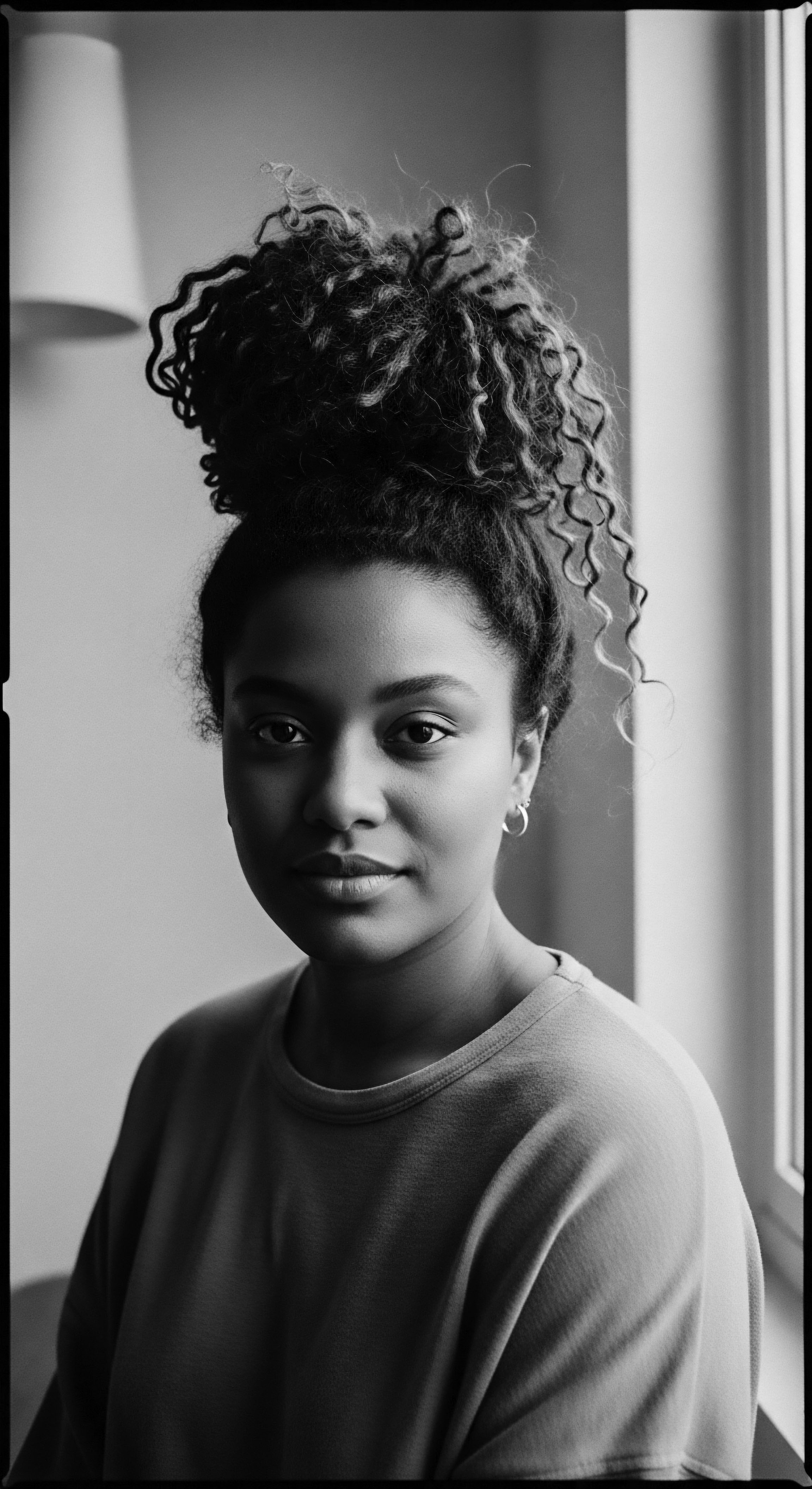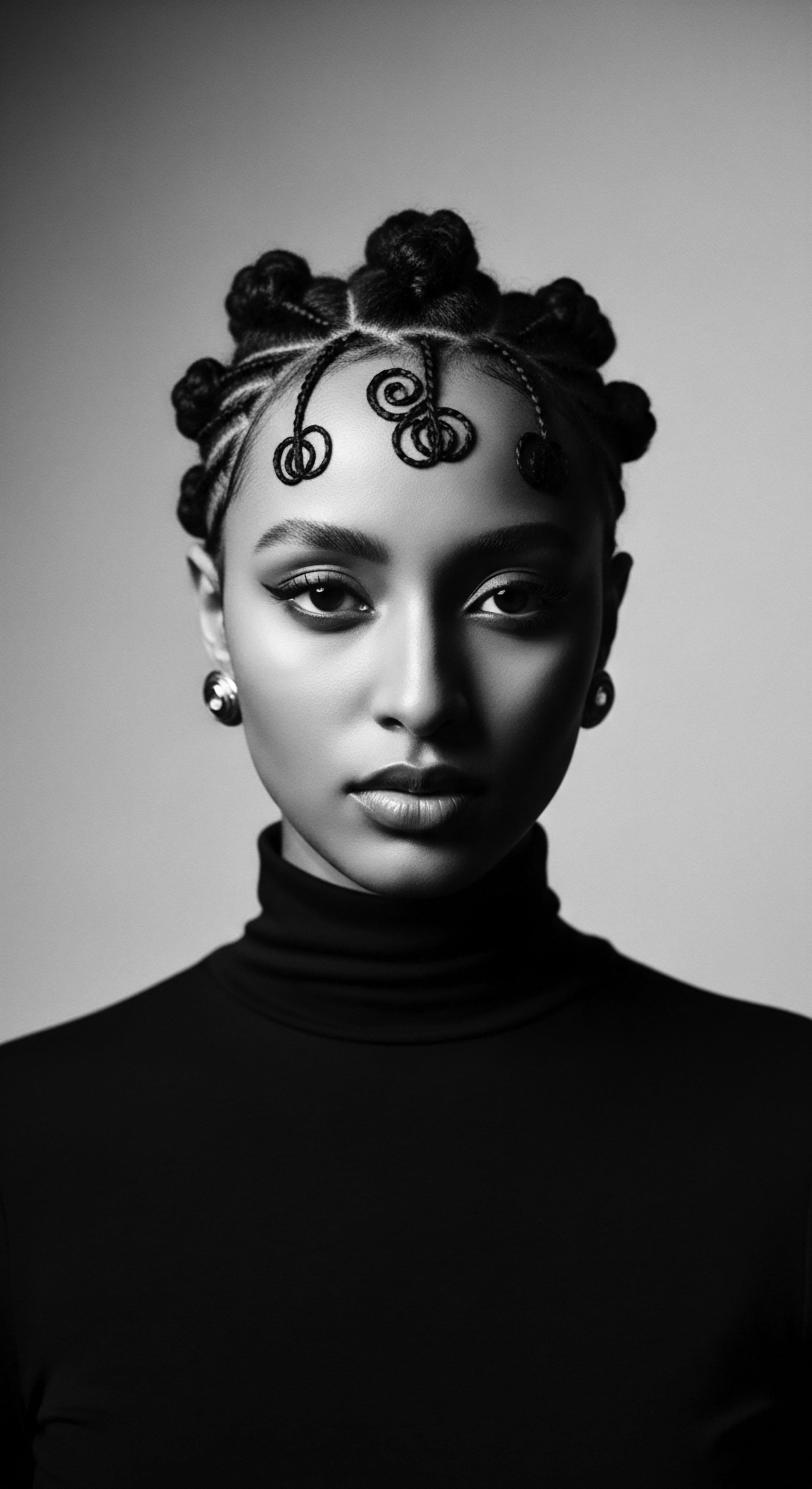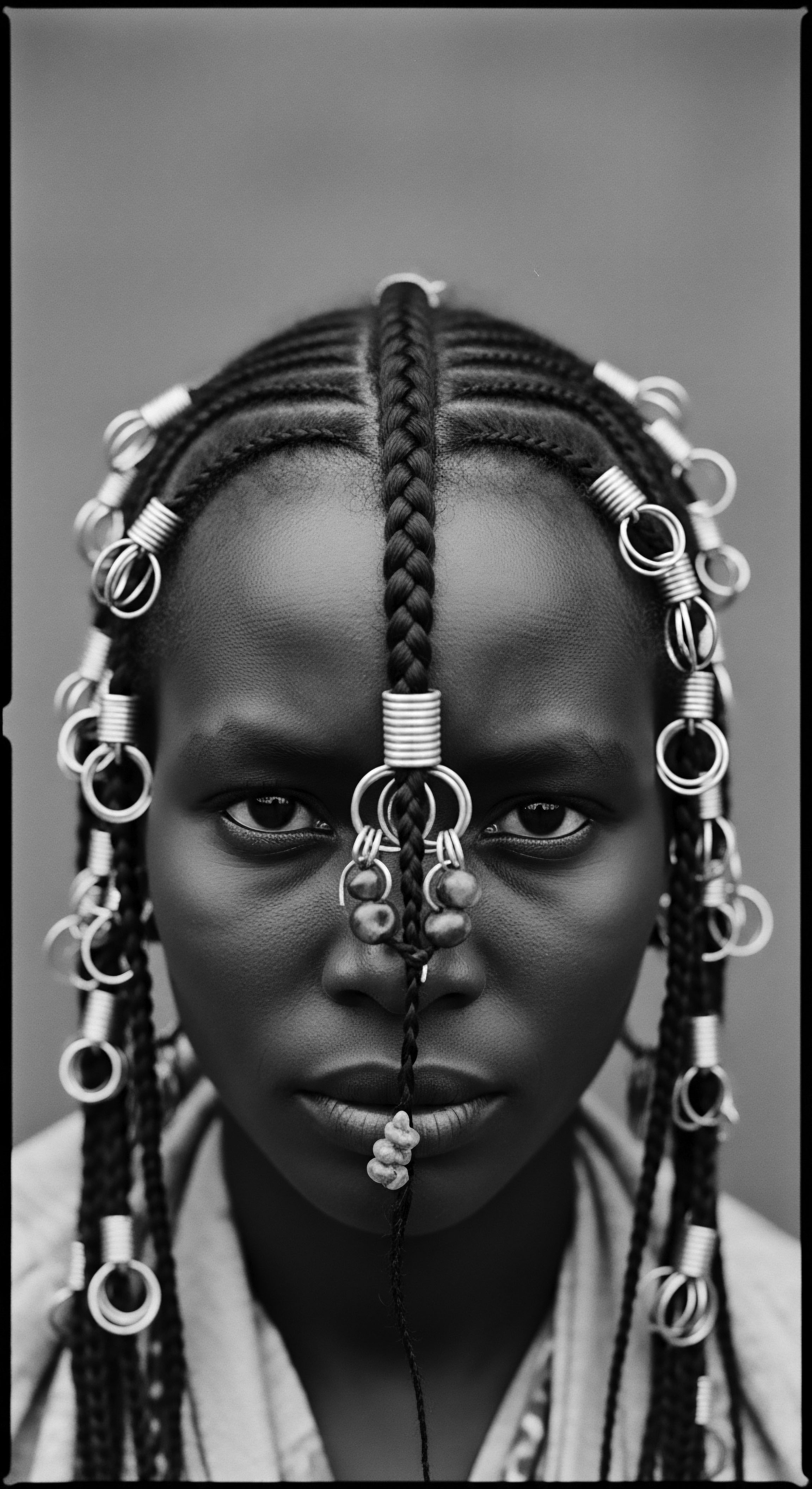
Roots
The very strands of our textured hair carry echoes from ancestral lands, a living archive of generations. For countless individuals across the globe, particularly those of African and diasporic descent, our coils and kinks are not mere biological constructs. They are intricate maps, charting journeys of resilience, creativity, and profound connection to heritage.
Understanding the care and protection afforded to these unique hair patterns—particularly through the ancient practice of head coverings, which finds its modern iteration in the bonnet—allows us to access a deeper appreciation for this legacy. It is a dialogue between the elemental biology of the hair shaft and the profound cultural meanings woven into its very existence.

The Architecture of Textured Strands
Our textured hair, from the tightest coils to the most expansive curls, possesses an architectural wonder distinct from straight or wavy hair types. Each strand emerges from its follicle not in a perfectly round cross-section, but often as an elliptical or even flat shape. This ovular structure, combined with the way the hair shaft twists as it grows, gives our hair its characteristic bends and spirals.
This inherent design also means a naturally raised cuticle layer, allowing moisture to escape more readily than in hair with a flatter, more closed cuticle. This biological truth underscores why protective measures, known throughout heritage , have always been a cornerstone of textured hair care.
The historical understanding of hair’s biological needs, though not articulated in modern scientific terms, was intrinsically linked to survival and wellness. Ancestral societies recognized the need for moisture retention and physical shielding. This understanding formed the basis of rituals and practical applications that guarded the hair against environmental aggressors—the sun’s intensity, the drying winds, the dust of daily life. The solutions were ingenious, drawing upon natural materials and communal wisdom, all aimed at preserving the strength and vitality of the hair that held such spiritual and social import.

Ancient Protective Garments
Across various African societies, head coverings were never simply about modesty or decoration. They possessed layered meanings, signifying status, marital standing, spiritual connection, and often, protection. Materials ranged from intricately woven fabrics, adorned with cowrie shells and beads, to simpler cloths dyed with plant extracts. These coverings shielded the hair from harsh elements, thereby preserving its condition and the elaborate styles that often symbolized identity and community .
The bonnet, in its contemporary form, stands as a direct descendant of the rich legacy of head coverings worn for hair protection and cultural expression across African and diasporic communities.
Consider the practices of ancient Kemet (Egypt) where wigs and hair extensions were commonplace, and elaborate hairstyles were protected during sleep and daily life by various coverings. Or the ceremonial headwraps of West Africa, such as the elaborate ‘gele’ of the Yoruba people, which, while visually striking, also served to protect intricate braids and twists underneath. These garments were not merely external coverings; they were integral to the holistic approach to hair, acknowledging its inherent vulnerability and its profound symbolic value.
The connection between these ancient practices and the modern usage of bonnets for textured hair is a testament to the enduring wisdom of our ancestors. The functional aspect of moisture preservation and friction reduction, understood intuitively for centuries, finds modern validation in hair science. Yet, beyond the practical, the bonnet carries a cultural memory, a quiet nod to a continuum of care that has survived displacement and disruption. It is a daily reaffirmation of a heritage that values and protects the unique beauty of textured hair.

From Veil to Veil ❉ A Legacy of Care
The evolution of head coverings for Black and mixed-race individuals is a story of adaptation and defiance. In pre-colonial African societies, the head wrap was a form of artistry and communication, often signifying age, marital status, or social standing. The transition to enslaved life in the Americas brought a new, often imposed, meaning to head coverings.
Yet, even in the most oppressive circumstances, the act of wrapping one’s hair became a quiet act of self-preservation and cultural continuity . It shielded hair from harsh labor conditions and served as a discreet marker of identity and dignity.
Over time, the simple cloth head wrap began its transformation, influenced by both necessity and changing textile availability. The bonnet, as we recognize it today, with its specific design for nighttime wear, arose from this confluence. It carried forward the practical need for protection, particularly as styles became more elaborate and the desire to preserve them overnight grew. This practicality, however, became deeply intertwined with the cultural narrative of Black women and men maintaining their hair’s health and appearance in a world that often devalued their aesthetic choices.

Ritual
The daily care of textured hair is, at its core, a living ritual . It involves deliberate acts, often passed down through generations, that speak to a profound connection with oneself and one’s lineage. Within this personal ceremony, the bonnet occupies a significant position, not merely as a utilitarian item, but as an object infused with meaning derived from centuries of hair traditions. Its presence in nightly routines links us directly to the protective practices and aesthetic values cultivated by our ancestors.

The Sacred Space of Nighttime Care
Nighttime offers a sanctuary for renewal, and for textured hair, it is a crucial period for restoration and preservation. This understanding is not new; indigenous traditions across various cultures often incorporated specific nightly routines to safeguard hair. The bonnet, therefore, is not a modern invention of convenience. It extends an ancient wisdom recognizing that undisturbed rest for the hair prevents tangles , minimizes breakage , and maintains the moisture carefully infused during daytime regimens.
Consider the delicate nature of textured strands when exposed to the friction of cotton pillowcases. The natural twists and turns of coily hair are particularly susceptible to snagging on rough fabrics, leading to damage and moisture loss. The smooth, often satin or silk, lining of a bonnet acts as a gentle shield, allowing hair to glide freely. This scientific understanding of friction aligns perfectly with the historical purpose of head coverings ❉ to create a protective barrier.
The very act of donning a bonnet before sleep becomes a quiet declaration of self-care. It speaks of intentionality, of valuing one’s hair not as a mere accessory, but as an integral part of one’s wellbeing. This ritual connects individuals to a collective experience, recognizing that countless others have performed similar acts of care throughout history, each bonnet a whisper of shared ancestral practices .

Bonnets and Protective Styling
Protective styles—braids, twists, cornrows—have been cornerstones of textured hair care and cultural expression for millennia. These styles, often requiring hours of meticulous work, were not only beautiful but served to minimize manipulation, thereby promoting length retention and health. The bonnet plays a crucial, complementary role in the preservation of these styles.
- Braiding Traditions ❉ Many West African cultures, such as the Fulani and the Mandinka, practiced intricate braiding patterns that signified social status or rites of passage. Protecting these styles during sleep was paramount to their longevity.
- Twist Patterns ❉ In parts of the Caribbean and the Americas, two-strand twists and similar styles gained prominence as practical, low-manipulation options. Bonnets aided in preserving the definition and neatness of these twists.
- Coil Set Preservation ❉ For centuries, natural coil patterns were enhanced with plant-based gels and oils. Bonnets protected these delicate sets from frizz and disruption overnight.
The bonnet ensures that the effort invested in these protective styles yields lasting results. By minimizing frizz and preventing the unraveling of braids or twists, it allows individuals to wear their styles for longer periods, reducing the frequency of manipulation and promoting overall hair health. This synergy between styling and protection mirrors the holistic approaches observed in historical hair care regimens where every step contributed to the overall vitality of the hair.
The bonnet serves as a quiet guardian of protective styles, extending their life and preserving the artistry and effort invested in them.
The relationship between bonnets and styling also speaks to an aesthetic heritage . Maintaining neat, well-preserved hair has long been a marker of pride and self-respect within Black and mixed-race communities. The bonnet, therefore, contributes to this aesthetic tradition, allowing individuals to wake with their hair largely intact, ready to face the day with confidence and a sense of continuity.

Beyond the Practical ❉ Bonnets as Symbols
While its practical benefits are undeniable, the cultural significance of the bonnet transcends mere utility. It has come to symbolize comfort, privacy, and a reclamation of intimate space. Within the home, the bonnet represents a shedding of public expectations, a moment of vulnerability and authentic self. It is a garment of rest, allowing for unvarnished self-expression away from external gazes.
In diasporic communities, particularly those shaped by the legacy of slavery and racial discrimination, hair became a site of both struggle and resistance. Textured hair was often policed, devalued, and deemed “unprofessional” in public spaces. The bonnet, therefore, also functions as a silent protest, a declaration that one’s natural hair, in its protected state, is inherently worthy of care and respect. It is a symbol of domestic autonomy, where the rituals of hair care are dictated by ancestral wisdom and personal well-being, rather than by external pressures.
The bonnet’s journey from a simple head covering to a culturally loaded garment reflects the evolving relationship Black and mixed-race individuals have with their hair. It is a quiet yet powerful affirmation of self-acceptance , a daily practice that connects the individual to a collective history of care, resilience, and the enduring celebration of textured hair.
| Traditional Practice Intricate head wraps (Gele, Tignon) |
| Cultural Origin/Context West Africa, Caribbean, Southern USA (forced or chosen) |
| Modern Bonnet Function Maintains elaborate hairstyles; reduces frizz; protects from elements. |
| Traditional Practice Sleep wraps (various materials) |
| Cultural Origin/Context Across numerous African societies |
| Modern Bonnet Function Preserves moisture; reduces friction on hair strands overnight. |
| Traditional Practice Ceremonial head coverings |
| Cultural Origin/Context Spiritual practices, rites of passage (various African cultures) |
| Modern Bonnet Function Signifies sanctity of hair; connection to self-care ritual. |
| Traditional Practice This table illustrates the enduring lineage of hair protection from ancient traditions to the contemporary bonnet. |

Relay
The cultural meaning of bonnet usage for textured hair is a story told across generations, a relay race of knowledge, resilience, and identity. It is a dynamic interplay of ancestral wisdom, scientific understanding, and the lived experiences of individuals navigating their relationship with their hair in a world that has often sought to dictate its presentation. The bonnet, seemingly a simple item, becomes a profound vehicle for this transmission, connecting past practices to present-day affirmations.

The Physiological Imperative of Protection
From a biological standpoint, textured hair, owing to its unique structure, is particularly susceptible to mechanical damage and moisture loss. The twists and turns along the hair shaft create natural points of weakness, making it more prone to breakage when subjected to friction or excessive manipulation. This inherent vulnerability underscores the physiological imperative for protection, a truth intuitively understood by generations before modern trichology.
A satin or silk bonnet mitigates these risks significantly. The smooth surface dramatically reduces friction against coarser fabrics like cotton, which can strip hair of its natural oils and create micro-abrasions along the cuticle. This protection preserves the hair’s lipid barrier, critical for retaining moisture and maintaining elasticity.
Scientific research on hair friction, while often generalized, supports the principle that smooth surfaces reduce damage to the hair cuticle (Robbins, 2012). This validation from contemporary science only deepens the appreciation for the long-standing effectiveness of these ancestral care practices .
The consistent use of bonnets and similar head coverings over time contributes to healthier hair cycles, promoting length retention and reducing the incidence of split ends. It supports the hair’s natural growth process by minimizing external stressors that impede its vitality. This continuous care, rooted in the nightly ritual, serves as a testament to the enduring understanding of hair’s delicate nature, an understanding passed down through generations.

Bonnets as Cultural Signifiers
The cultural significance of the bonnet extends beyond its practical benefits; it functions as a powerful signifier of cultural identity and belonging within Black and mixed-race communities. For many, the sight of a bonnet signals a shared understanding, an unspoken acknowledgement of a common heritage of hair care practices. It is an item that bridges the gap between private care and public identity, even when worn strictly within the confines of the home.
This shared understanding has also, at times, become a point of contention. The bonnet, when worn outside the home, has sometimes been subjected to public scrutiny and judgment, often rooted in anti-Black racism and attempts to control Black bodies and their aesthetics. This external gaze, however, does not diminish its internal cultural meaning.
Instead, it highlights the resilience and quiet defiance inherent in its continued use. The decision to wear a bonnet publicly, for some, is a reclaiming of space and a challenge to respect their chosen presentation of self, steeped in cultural comfort rather than conforming to dominant norms.
The bonnet, both a practical tool and a cultural emblem, quietly challenges narrow beauty standards by affirming the inherent worth of textured hair and its heritage.
The bonnet has also been embraced by a wider audience as awareness of its benefits for textured hair has grown. Yet, it remains intrinsically linked to its origins, a thread connecting contemporary users to a rich lineage of hair knowledge. This broader adoption, when done respectfully, can contribute to a greater appreciation for the historical ingenuity of Black hair practices.

The Bonnet and Collective Memory
The bonnet carries a profound collective memory within the diaspora. It evokes images of grandmothers and mothers, of shared moments of hair care, of whispered wisdom and gentle hands. It is a symbol of nurturing and protection, not just for the hair itself, but for the wearer. This emotional resonance transforms the simple fabric item into a powerful artifact of familial and communal bonds.
The practice of hair care in Black communities has often been a communal event, particularly for women. From wash days to braiding sessions, these moments were opportunities for storytelling, mentorship, and the transmission of cultural values . The bonnet, as an integral part of maintaining these styles, becomes part of this rich narrative. It symbolizes the continuity of care that transcends generations, a silent guardian of hair histories and the personal stories tied to each strand.
In a world constantly evolving, the bonnet serves as an anchor to tradition. Its consistent presence in nighttime routines across various cultures and demographics within the Black diaspora speaks volumes about its enduring value. It stands as a humble yet mighty guardian of textured hair heritage , a testament to the wisdom that understands the deep connection between hair, identity, and wellbeing. The bonnet, in its quiet grace, continues to relay these essential truths to new generations.
Consider the case of the “tignon” in colonial Louisiana. Enforced by sumptuary laws in the late 18th century, Black women were compelled to wear head coverings as a marker of their race and social standing. However, these women, known for their artistry, transformed the mandated headwrap into an elaborate and beautiful fashion statement, adorned with jewels and rich fabrics (Bell, 2003).
This act of defiance and transformation mirrors the enduring spirit that gives the bonnet its current cultural weight. It is a legacy of taking what was perhaps imposed or merely practical, and infusing it with meaning, beauty, and resistance .

Reflection
As the moonlight spills through the window, illuminating the quiet space of night, the bonnet rests upon the head, a soft crown embracing textured strands. This simple act, repeated nightly by millions, is far grander than mere routine. It is a quiet homage, a powerful declaration, and a living continuum of ancestral wisdom. The bonnet is truly a vessel of our textured hair heritage , whispering stories of resilience, care, and identity across the long expanse of time.
Each strand holds a history, a narrative of survival and triumph. The very act of protecting these strands—whether from the harsh sun of an ancient savannah, the rigors of forced labor, or the daily friction of modern life—is a profound act of self-love and cultural affirmation. The bonnet, therefore, is not just about reducing frizz or retaining moisture; it is about honoring the journey of our hair, acknowledging its biological unique qualities, and celebrating the deep roots from which it springs.
It embodies the ‘Soul of a Strand’ ethos, recognizing hair as a sacred, living part of our being, intertwined with our collective story. Its presence in our daily lives reminds us that the pursuit of wellness for textured hair is always a reconnection with a luminous and enduring heritage .

References
- Bell, Carey. (2003). The Tignon and the Louisiana Creoles. University of Louisiana Press.
- Robbins, Clarence. (2012). Chemical and Physical Behavior of Human Hair. Springer.
- Byrd, Ayana. (2001). Hair Story ❉ Untangling the Roots of Black Hair in America. St. Martin’s Press.
- Thurman, Judith. (2018). The Veil ❉ Its History and Its Many Meanings. Penguin Books.
- Kittles, Rick. (2004). African Hair Morphology and Its Adaptation to Climate. Journal of Human Evolution.
